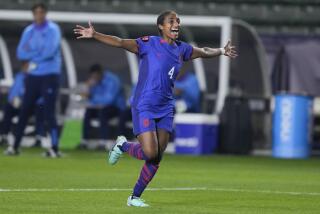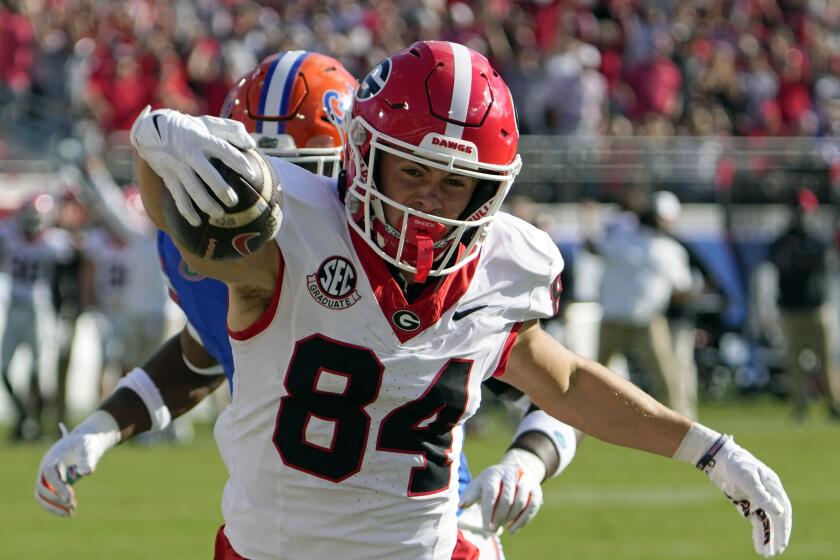Soccer really is child’s play for U.S. women’s team
Abby Wambach, arguably the most feared women’s soccer player on the planet, is sitting, feet spread, on the floor of a hotel hallway patiently teaching 7-year-old Lily Ellis how to read.
“What does that say? Sound it out,” prods Wambach, pointing to a sign hanging from a doorknob.
“Do not disturb?” says Lily, the daughter of U.S. national team assistant coach Jill Ellis.
Wambach insists having Lily with the team is no disturbance. The same goes for 6-year-old Rylie and 2-year-old Reece, the daughters of defender Christie Rampone. Children are to be neither seen nor heard around many national teams, but they’ve been welcomed by the U.S. women’s Olympic soccer squad.
“Oh, heck yeah,” says Wambach, who is both the second-highest scorer and the self-proclaimed best baby-sitter on the team. “You spend so much time away from home there’s only so many TV shows you can watch. There’s only so many conversations you can have. The added component of having kids around, it just is entertainment.
“It’s just such a great dynamic to bring into a team environment that can sometimes get monotonous.”
More important, however, is that it can extend careers as well. Which is why U.S. Soccer not only allows players to bring their children on the road for training and tournaments but, for the past 16 years, has been paying the expenses for both the kids and their nannies.
“U.S. Soccer considers this an important element to help those players with children to continue to contribute,” says national team spokesman Neil Buethe. “It allows the players to concentrate on their job of playing soccer without having to be away from their kids for a long period of time or worry about how they’re going to be able to balance their family and career while being on the road during training camp.”
The program, which has been around since just before the 1996 Summer Games in Atlanta, was modeled after one used on the LPGA Tour. U.S. softball borrowed the idea for the three mothers on its 2008 Beijing team, but the “soccer nanny program” is the only one currently being used by an American Olympic team.
And without it Rampone, the U.S. captain, wouldn’t be going to London. She had already played in two Olympics and two World Cups when she and her husband Chris decided to start a family after the 2004 Athens Games, even if it meant the end of her playing career.
“I was 100% OK with knowing that this was the next step in my life,” she says. “If I couldn’t come back I’d be disappointed, but we still would have been able to move on with our lives.”
She certainly wasn’t the first woman to reach that crossroads. Three years before Rampone joined the national team, defender Joy Fawcett — part of the fabled Fab Five of U.S. soccer, which also included Mia Hamm, Julie Foudy, Kristine Lilly and Brandi Chastain — had considered quitting to have a baby.
But first Fawcett, 27 at the time, went to then-coach Anson Dorrance with an idea.
“I’m going to have kids and I’m going to bring them with me. Is that OK with you?” Fawcett, now 44, remembers asking. “And he said ‘yeah, that’s fine.’”
“That’s all I wanted,” Fawcett says. “Just to be able to bring them along.”
Before her daughter Katey was a year old, Fawcett was not only back on the team, but she played every minute in the 1995 World Cup, becoming the first U.S. player to give birth and return to the highest levels of international soccer. She would spend nine more years with the national team before retiring with two World Cup victories, two Olympic gold medals and three children. Five years later she was inducted into the National Soccer Hall of Fame.
“It would have been very easy for them to say ‘you know what? You . . . can’t take the kid on the road with you,’” says Walter Fawcett, Joy’s husband. “If they had said it, it would have been game over.”
But approving the idea brought new challenges. At first Joy Fawcett took care of Katey by herself, paying to upgrade to a private room on the road and following two-a-day practices with midnight feedings.
“There were points where I was tired,” she remembers.
And that wasn’t even her biggest concern. By the time Fawcett’s second daughter, Carli, was old enough to join her sister on the road, teammate Carla Overbeck was traveling with her year-old son Jackson, leaving both women worrying that the children might have a negative impact on their teammates.
Instead the opposite happened. The players started unwinding after practices and before tense matches by racing the kids up and down hallways, playing games with them or helping them build leprechaun traps in the team hotel.
“One of the unintended side effects was what it did for team chemistry,” Walter Fawcett says. “I think it’s easier for the women because more of the women are going to connect with young kids and enjoy going into the hallway and making a leprechaun trap. Doing something silly instead of always soccer.”
The children lightened the mood in other ways as well. After a heartbreaking overtime loss to Norway in the 2000 Olympic final, Fawcett said the team was disappointed with its silver medals. But after the medal ceremony the players were greeted at the end of the field by Fawcett’s daughter Katey, who clutched at her mother’s consolation prize.
“It’s beautiful! The most beautiful thing I’ve ever seen,” Fawcett remembers her daughter saying. “I was like, ‘You’re right. What’s there to be sad about?’”
By then U.S. Soccer was inviting nannies — who were often friends or relatives of the players — to travel with the team, paying for their airfare, meals and hotel rooms and giving them a small daily stipend. The number of competitions and training camps where nannies are needed can vary widely from year to year so U.S. Soccer couldn’t say what it spends on the program. But Buethe insists it’s worth the cost.
“The easiest thing to say is that it’s an expense that we think is 100% worthwhile,” he says. “Because it helps the players prepare and concentrate on playing soccer. It’s an important thing for us to be successful.”
And it’s good for the children, too.
“They’re very self-sufficient,” Rampone, who turns 37 Sunday, says of her children. “They know how to travel. They know how to deal with adversity but they also know respect. They learn so much on the road.”
Sometimes too much.
“We have to do hydration tests in the morning so [Rylie] knows ‘pee in a cup,’” Rampone says.
And Fawcett’s children sat in on so many team meetings that when one of them had an accident on a team flight, she blamed it on a loss of focus.
Still, it takes time for some to warm to the program. When Pia Sundhage was named coach of the U.S. team in 2007 she admitted she liked dogs better than kids.
“They’re easier,” she says. “To be honest, I’m awkward with kids.”
But the famously laid-back Sundhage — who opened her first team meeting as coach by pulling out a guitar and playing Bob Dylan songs — isn’t about to mess with success.
“I’m amazed how the team is around kids,” she says. “And the other thing is . . . when you’re nervous and you’re tight before you have to perform, sometimes it’s good fooling around with a kid.
“They do a good job and they make it work. It’s fairly unique.”
More to Read
Get our high school sports newsletter
Prep Rally is devoted to the SoCal high school sports experience, bringing you scores, stories and a behind-the-scenes look at what makes prep sports so popular.
You may occasionally receive promotional content from the Los Angeles Times.







